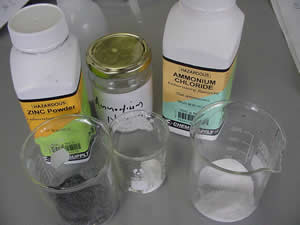Start a fire with
water
Take care and
read the safety instructions at the bottom of the page.
You will need:
- Ammonium nitrate 14.0 grams
- Ammonium chloride 1.5 grams
- Zinc dust 34.5 grams
Weigh them separately as shown
on the right. Use dry beakers. Only mix them when you are ready to demonstrate
the reaction.
Do not pre mix the chemicals.

Place the mixture in a crucible and place a drop of water on the mixture. Quickly stand well back. The reaction will cause a great deal of heat and powder (zinc oxide) to form.

Safety notes
This reaction is highly exothermic (gives off heat). It ignites spontaneously at the slightest contact with water. Once mixed, this powder should be used immediately and never stored under any conditions as water vapour in the air will cause spontaneous combustion.
The chemistry behind this reaction is given below.
1) After the reaction can you
smell chlorine? Where do you think this chlorine gas comes from?
2) Why are the flames bright green?
3) Greek fire is said to have ignited in water.
Could this mixture have been prepared by the Ancient Greeks?
Was ammonium nitrate and ammonium chloride available during the Byzantine
Empire?
Senior chemistry
Cl- from the dissolving of NH4Cl catalyses the decomposition
of ammonium nitrate according to the equation below.
NH4NO3(s)
=> N2O(g) + 2H2O(l) This reaction
is exothermic and the heat given off melts the NH4NO3
and allows the oxidation of zinc. The overall reaction is summarised
below.
Zn(s) + NH4NO3(s) => N2(g)
+ ZnO(s) + 2H2O(g)
What is the change in oxidation state of Zn?
What is the oxidation state of N in NH4NO3?
Identify the reductant?
Identify the oxidant?